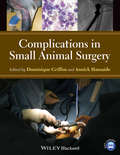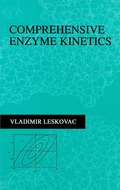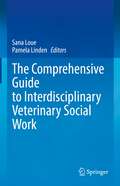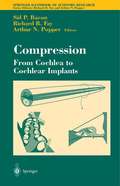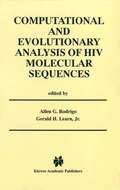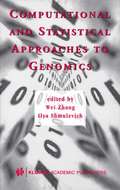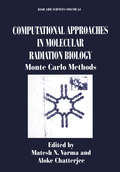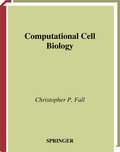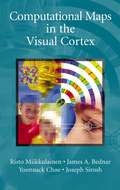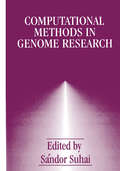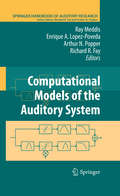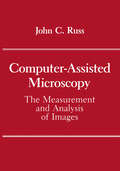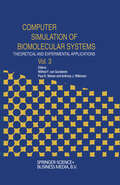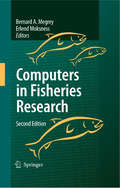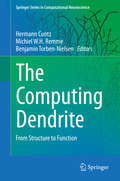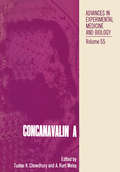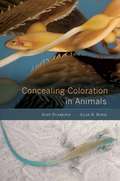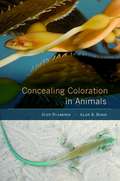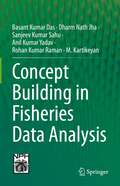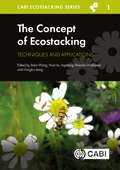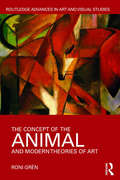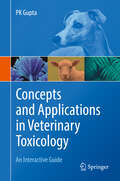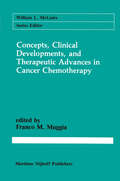- Table View
- List View
Complications in Small Animal Surgery
by Dominique J. Griffon Annick HamaideComplications in Small Animal Surgery provides a complete reference to diagnosing, managing, and treating surgical complications, with information following a standardized format for ease of use. • Presents comprehensive information on diagnosing, managing, and preventing surgical complications using an accessible format • Offers a well-defined, thoroughly illustrated format to maximize practical value, with algorithms, tables, practical tips, and many images throughout • Covers common and uncommon complications in all body systems • Serves as a reference to recent literature relevant to each complication • Includes access to a companion website with videos, figures from the book available for download into PowerPoint, and linked references at www.wiley.com/go/griffon/complications
Comprehensive Enzyme Kinetics
by Vladimir LeskovacWelcome to your study of enzyme kinetics, the subject that underlies all enzymology, which in turn underlies all aspects of biochemistry. This text will give you an introduction to a wide range of topics that constitute the modern enzyme kinetics. This textbook is directed at graduate students in biochemistry, chemistry, and life sciences, for advanced courses in enzyme kinetics, enzymology, and enzyme chemistry. For this reason, the whole book is organized in a systematic and scholarly fashion. It is unlikely that the student will be expected to cover everything in the text, but in a later career she or he may find it an invaluable reference for topics that are needed in practice. The concepts, definitions and detailed algebra of enzyme kinetics are laid out in accurate detail. For that reason, this textbook can also serve as a handbook for enzyme kinetics for research workers in the field. The research worker will find it a useful source, which can be used for solving the daily experimental problems in the laboratory. The preparation of the manuscript for this book was under the constant surveillance of W. Wallace Cleland, Professor of Chemical Science at the University of Wisconsin in Madison, and one of the founders of modern enzyme kinetics. Without his help and advice, this bookwould not be possible. Several versions of the manuscript were constantly corrected and improved by Svetlana Professor of Biochemistry at the University of Novi Sad.
The Comprehensive Guide to Interdisciplinary Veterinary Social Work
by Sana Loue Pamela LindenThis book responds to the needs that arise at the intersection of people and animals, focusing on human-animal interaction, human-animal studies, the emotional work of caring for animals, and animal-assisted interventions and therapies. Unlike many works that focus primarily on issues at the micro level, such as animal-assisted interventions, this volume is unique in its focus on issues arising at the micro, macro, and mezzo levels, encompassing human-animal issues and interactions at the level of individuals and family, groups, institutions, and communities. Accordingly, this comprehensive guide addresses the need to better prepare practitioners to work in interdisciplinary environments, whether in the context of theory, research, practice, or advocacy. The authorship of the volume reflects the interdisciplinary foundations of veterinary social work, with contributions from social workers, psychologists, veterinarians, physicians, anthropologists, and bioethicists.The volume is divided into five parts that examine, respectively:the foundations (history and scope) of veterinary social work (Part I); the practice of veterinary social work with individuals, in the context of community programs, and in social work practice (Part II); veterinary social work and the veterinary setting, including veterinary well-being and conflict management (Part III); veterinary social work education (Part IV); and the future of veterinary social work (Part V). Importantly, the volume addresses not only practice issues in the veterinary, clinical, and community settings, but also examines ethical concerns in the clinical and research contexts and the implications of cultural and societal variations on the practice of veterinary social work.The Comprehensive Guide to Interdisciplinary Veterinary Social Work is the definitive resource for social workers and psychologists new to practice issues relating to animals, social work and psychology students at the graduate and undergraduate levels, veterinarians and veterinary students, hospital administrators (human hospitals), and veterinary hospital managers.
Comprehensive Virology: 17 Methods Used in the Study of Viruses
by Heinz Fraenkel-Conrat Robert R. WagnerThe time seems ripe for a critical compendium of that segment of the biological universe we call viruses. Virology, as a science, having passed only recently through its descriptive phase of naming and num bering, has probably reached that stage at which relatively few new truly new-viruses will be discovered. Triggered by the intellectual probes and techniques of molecular biology, genetics, biochemical cytology, and high resolution microscopy and spectroscopy, the field has experienced a genuine information explosion. Few serious attempts have been made to chronicle these events. This comprehensive series, which will comprise some 6000 pages in a total of about 18 volumes, represents a commitment by a large group of active investigators to analyze, digest, and expostulate on the great mass of data relating to viruses, much of which is now amorphous and disjointed, and scattered throughout a wide literature. In this way, we hope to place the entire field in perspective, and to develop an invalua ble reference and sourcebook for researchers and students at all levels. This series is designed as a continuum that can be entered anywhere, but which also provides a logical progression of developing facts and integrated concepts.
Compression: From Cochlea to Cochlear Implants (Springer Handbook of Auditory Research #17)
by Richard R. Fay Sid BaconThe Springer Handbook of Auditory Research presents a series of comp- hensive and synthetic reviews of the fundamental topics in modern au- tory research.The volumes are aimed at all individuals with interests in hearing research including advanced graduate students, post-doctoral researchers, and clinical investigators.The volumes are intended to int- duce new investigators to important aspects of hearing science and to help established investigators to better understand the fundamental theories and data in ?elds of hearing that they may not normally follow closely. Each volume is intended to present a particular topic comprehensively, and each chapter will serve as a synthetic overview and guide to the lit- ature.As such the chapters present neither exhaustive data reviews nor original research that has not yet appeared in peer-reviewed journals.The volumes focus on topics that have developed a solid data and conceptual foundation rather than on those for which a literature is only beginning to develop. New research areas will be covered on a timely basis in the series as they begin to mature.
Computational and Evolutionary Analysis of HIV Molecular Sequences
by Allen G. Rodrigo Gerald H. LearnComputational and Evolutionary Analysis of HIV Molecular Sequences is for all researchers interested in HIV research, even those who only have a nodding acquaintance with computational biology (or those who are familiar with some, but not all, aspects of the field). HIV research is unusual in that it brings together scientists from a wide range of disciplines: clinicians, pathologists, immunologists, epidemiologists, virologists, computational biologists, structural biologists, evolutionary biologists, statisticians and mathematicians. This book seeks to bridge the gap between these groups, in both subject matter and terminology. Focused largely on HIV genetic variation, Computational and Evolutionary Analysis of HIV Molecular Sequences covers such issues as sampling and processing sequences, population genetics, phylogenetics and drug targets.
Computational and Statistical Approaches to Genomics
by Ilya Shmulevich Wei Wei ZhangComputational and Statistical Genomics aims to help researchers deal with current genomic challenges. Topics covered include: overviews of the role of supercomputers in genomics research, the existing challenges and directions in image processing for microarray technology, and web-based tools for microarray data analysis; approaches to the global modeling and analysis of gene regulatory networks and transcriptional control, using methods, theories, and tools from signal processing, machine learning, information theory, and control theory; state-of-the-art tools in Boolean function theory, time-frequency analysis, pattern recognition, and unsupervised learning, applied to cancer classification, identification of biologically active sites, and visualization of gene expression data; crucial issues associated with statistical analysis of microarray data, statistics and stochastic analysis of gene expression levels in a single cell, statistically sound design of microarray studies and experiments; and biological and medical implications of genomics research.
Computational Approaches in Molecular Radiation Biology: Monte Carlo Methods (Basic Life Sciences #63)
by Matesh N. Varma Aloke ChatterjeeThe Office of Health and Environmental Research (OHER) has supported and continues to support development of computational approaches in biology and medicine. OHER's Radiological and Chemical Physics Program initiated development of computational approaches to determine the effects produced by radiation of different quality (such as high energy electrons, protons, helium and other heavy ions, etc. ) in a variety of materials of biological interest-such as water, polymers and DNA; these include molecular excitations and sub-excitations and the production of ionization and their spatial and temporal distribution. In the past several years, significant advances have been made in computational methods for this purpose. In particular, codes based on Monte Carlo techniques have ·been developed that provide a realistic description of track-structure produced by charged particles. In addition, the codes have become sufficiently sophisticated so that it is now possible to calculate the spatial and temporal distribution of energy deposition patterns in small volumes of subnanometer and nanometer dimensions. These dimensions or resolution levels are relevant for our understanding of mechanisms at the molecular level by which radiations affect biological systems. Since the Monte Carlo track structure codes for use in radiation chemistry and radiation biology are still in the developmental stage, a number of investigators have been exploring different strategies for improving these codes.
Computational Cell Biology (Interdisciplinary Applied Mathematics #20)
by Christopher P. Fall Eric S. Marland John M. Wagner John J. TysonThis textbook provides an introduction to dynamic modeling in molecular cell biology, taking a computational and intuitive approach. Detailed illustrations, examples, and exercises are included throughout the text. Appendices containing mathematical and computational techniques are provided as a reference tool.
Computational Maps in the Visual Cortex
by Risto Miikkulainen James A. Bednar Yoonsuck Choe Joseph SiroshFor more than 30 years, the visual cortex has been the source of new theories and ideas about how the brain processes information. The visual cortex is easily accessible through a variety of recording and imagining techniques and allows mapping of high level behavior relatively directly to neural mechanisms. Understanding the computations in the visual cortex is therefore an important step toward a general theory of computational brain theory.
Computational Methods in Genome Research
by Sandor SuhaiThe application of computational methods to solve scientific and pratical problems in genome research created a new interdisciplinary area that transcends boundaries traditionally separating genetics, biology, mathematics, physics, and computer science. Computers have been, of course, intensively used for many year~ in the field of life sciences, even before genome research started, to store and analyze DNA or proteins sequences, to explore and model the three-dimensional structure, the dynamics and the function of biopolymers, to compute genetic linkage or evolutionary processes etc. The rapid development of new molecular and genetic technologies, combined with ambitious goals to explore the structure and function of genomes of higher organisms, has generated, however, not only a huge and burgeoning body of data but also a new class of scientific questions. The nature and complexity of these questions will require, beyond establishing a new kind of alliance between experimental and theoretical disciplines, also the development of new generations both in computer software and hardware technologies, respectively. New theoretical procedures, combined with powerful computational facilities, will substantially extend the horizon of problems that genome research can ·attack with success. Many of us still feel that computational models rationalizing experimental findings in genome research fulfil their promises more slowly than desired. There also is an uncertainity concerning the real position of a 'theoretical genome research' in the network of established disciplines integrating their efforts in this field.
Computational Models of the Auditory System (Springer Handbook of Auditory Research #35)
by Ray Meddis Enrique A. A. Lopez-Poveda Richard R. R. Fay Arthur N. N. PopperThe Springer Handbook of Auditory Research presents a series of comprehensive and synthetic reviews of the fundamental topics in modern auditory research. The v- umes are aimed at all individuals with interests in hearing research including advanced graduate students, post-doctoral researchers, and clinical investigators. The volumes are intended to introduce new investigators to important aspects of hearing science and to help established investigators to better understand the fundamental theories and data in fields of hearing that they may not normally follow closely. Each volume presents a particular topic comprehensively, and each serves as a synthetic overview and guide to the literature. As such, the chapters present neither exhaustive data reviews nor original research that has not yet appeared in pe- reviewed journals. The volumes focus on topics that have developed a solid data and conceptual foundation rather than on those for which a literature is only beg- ning to develop. New research areas will be covered on a timely basis in the series as they begin to mature.
Computer-Assisted Microscopy: The Measurement and Analysis of Images
by John C. RussThe use of computer-based image analysis systems for all kinds of images, but especially for microscope images, has become increasingly widespread in recent years, as computer power has increased and costs have dropped. Software to perform each of the various tasks described in this book exists now, and without doubt additional algorithms to accomplish these same things more efficiently, and to perform new kinds of image processing, feature discrimination and measurement, will continue to be developed. This is likely to be true particularly in the field of three-dimensional imaging, since new microscopy methods are beginning to be used which can produce such data. It is not the intent of this book to train programmers who will assemble their own computer systems and write their own programs. Most users require only the barest of knowledge about how to use the computer, but the greater their understanding of the various image analysis operations which are possible, their advantages and limitations, the greater the likelihood of success in their application. Likewise, the book assumes little in the way of a mathematical background, but the researcher with a secure knowledge of appropriate statistical tests will find it easier to put some of these methods into real use, and have confidence in the results, than one who has less background and experience. Supplementary texts and courses in statistics, microscopy, and specimen preparation are recommended as necessary.
Computer Simulation of Biomolecular Systems: Theoretical and Experimental Applications (Computer Simulations of Biomolecular Systems #3)
by W. F. Van Gunsteren P. K. Weiner A. J. WilkinsonThe third volume in the series on Computer Simulation of Biomolecular Systems continues with the format introduced in the first volume [1] and elaborated in the second volume [2]. The primary emphasis is on the methodological aspects of simulations, although there are some chapters that present the results obtained for specific systems of biological interest. The focus of this volume has changed somewhat since there are several chapters devoted to structure-based ligand design, which had only a single chapter in the second volume. It seems useful to set the stage for this volume by quoting from my preface to Volume 2 [2]. "The long-range 'goal of molecular approaches to biology is to describe living systems in terms of chemistry and physics. Over the last fifty years great progress has been made in applying the equations representing the underlying physical laws to chemical problems involv ing the structures and reactions of small molecules. Corresponding studies of mesoscopic systems have been undertaken much more recently. Molecular dynamics simulations, which are the primary focus of this volume, represent the most important theoretical approach to macromolecules of biological interest." ...
Computers in Fisheries Research
by Bernard A. Megrey Erlend MoksnessThe first edition of this book was published by Chapman and Hall Ltd. in 1996. The first edition contained nine chapters and, for all except one chapter, the original chapter authors agreed to update their chapter. Comparing these chapters gives the reader an idea of the development over a time span of more than 10 years between the two editions. In the preparation of the second edition we decided to add more chapters reflecting some important fields with significant contributions to present day fishery research. These are the use of internet for searching of information (Chapter 2), and the present state and use of remote sensing (Chapter 5), ecosystem modeling (Chapter 8) and visualization of data (Chapter 10). This second edition provides a valuable sampling of contemporary applications. Scientists have an opportunity to evaluate the suitability of different computer technology applications to their particular research situation thereby taking advantage of the experience of others. The chapters that follow are the fruition of this idea. The history behind this book started in 1989 when we were asked by Dr. Vidar Wespestad (previously: Alaska Fisheries Science Center, Seattle, USA) to prepare and convene a session at the 1992 World Fishery Congress in Athens, Greece on computer applications in fisheries. We agreed that the idea was a good one and the computer session in 1992 turned out to be very successful.
The Computing Dendrite: From Structure to Function (Springer Series in Computational Neuroscience #11)
by Hermann Cuntz Michiel W. H. Remme Benjamin Torben-NielsenNeuronal dendritic trees are complex structures that endow the cell with powerful computing capabilities and allow for high neural interconnectivity. Studying the function of dendritic structures has a long tradition in theoretical neuroscience, starting with the pioneering work by Wilfrid Rall in the 1950s. Recent advances in experimental techniques allow us to study dendrites with a new perspective and in greater detail. The goal of this volume is to provide a résumé of the state-of-the-art in experimental, computational, and mathematical investigations into the functions of dendrites in a variety of neural systems.The book first looks at morphological properties of dendrites and summarizes the approaches to measure dendrite morphology quantitatively and to actually generate synthetic dendrite morphologies in computer models. This morphological characterization ranges from the study of fractal principles to describe dendrite topologies, to the consequences of optimization principles for dendrite shape. Individual approaches are collected to study the aspects of dendrite shape that relate directly to underlying circuit constraints and computation.The second main theme focuses on how dendrites contribute to the computations that neurons perform. What role do dendritic morphology and the distributions of synapses and membrane properties over the dendritic tree have in determining the output of a neuron in response to its input? A wide range of studies is brought together, with topics ranging from general to system-specific phenomena—some having a strong experimental component, and others being fully theoretical. The studies come from many different neural systems and animal species ranging from invertebrates to mammals. With this broad focus, an overview is given of the diversity of mechanisms that dendrites can employ to shape neural computations.
Concanavalin A (Advances in Experimental Medicine and Biology #55)
by Tushar ChowdhuryConcanavalin A (Con A), a plant lectin, has become an object of extensive research not only for the biochemist, but also for the bi ologist, biophysicist, pathologist, immunologist and others. On April 19-20, 1974 a group of scholars from four continents met on the campus of the University of Oklahoma for an International Symposium on Con A. This volume contains all lectures presented by the invited speakers on this occasion, as well as the abstracts for all shorter technical papers which were presented. Further, the edi tors invited additional contributions from a few selected laboratories to cover the areas not covered in the symposium itself. This volume then reports the present status of research with Con A. In a sense it is encyclopedic and should be a useful reference tool to the worker in this field. The newcomer to this area will find that a careful study of this book will bring him up-to-date with the latest techniques, ap proaches and the "state of the art" in this specialized area of re search, as well as with traps and ensnarements in which he need not get entangled again. Starting at the molecular level and advancing from there to the organismic level as well as to a number of highly specialized areas, this volume presents the most complete survey of research findings with Con A available today. The editors wish to acknowledge the generous financial support provided by the University of Oklahoma through its President, Dr.
Concealing Coloration in Animals
by Judy DiamondColor can attract mates, intimidate enemies, and distract predators. But it can also conceal animals from detection. It is an adaptation to the visual features of the environment but also to the perceptual and cognitive capabilities of other organisms. Judy Diamond and Alan Bond reveal factors at work in the evolution of concealing coloration.
Concealing Coloration in Animals
by Judy DiamondColor can attract mates, intimidate enemies, and distract predators. But it can also conceal animals from detection. It is an adaptation to the visual features of the environment but also to the perceptual and cognitive capabilities of other organisms. Judy Diamond and Alan Bond reveal factors at work in the evolution of concealing coloration.
Concept Building in Fisheries Data Analysis
by Basant Kumar Das Dharm Nath Jha Sanjeev Kumar Sahu Anil Kumar Yadav Rohan Kumar Raman M. KartikeyanThis authored book is primarily for the readers who are in search of how to use basic concepts of statistics in the field of fishery science. It has been written for the new comers coming in the fishery sector including university students, teachers and research scholars. It enriches the reader’s knowledge of data analysis step by step starting from data collection to its analysis and interpretation along with practical application with real example. It supports readers for enhancing theoretical and practical concept of application of fundamental statistics in fishery domain. Reader may also learn how to analyses data using different statistical software. Each chapter starts with an introduction of the topic followed by statistical concept with example and ends with chapter based question for comprehension purpose. This book is of interest to teachers, researchers, scientists, capacity builders in fishery sciences. Also the book serves as additional reading material for undergraduate and graduate students of fisheries and aquatic sciences.
The Concept of Ecostacking: Techniques and Applications (Ecostacking Series)
by Heikki M.T. Hokkanen Dr Ingeborg Menzler-Hokkanen James D Blande Fanny Boerave Dr Daniel Carrillo Tomislav Cernava Xiaoyulong Chen Wen-Qiang Chu Gloria Gauthura Severin Hatt Jarmo K Holopainen Fathiya Khamis Pål Kvello Guang-Yun Li Dr Yaying Li Beatrice Muriithi Jinzhi Niu Levi Ombura Xian Wang Ziying Wang Qiu Yang Wei Yixia Wu Li Ya-Ying Kaijun ZhangEcostacking is a new concept and approach which aims to maximize the benefits of ecosystem service providers in cropping systems to help achieve the goal of long-term sustainable agriculture and food production. The term "ecostacking" means combining synergistically the beneficial services of functional biodiversity from all levels and types. It is a comprehensive approach, where the various ecosystem service providers are fully integrated with the rest of the cropping system including agronomic practices. It is an approach which goes beyond conventional Integrated Pest Management practises, and attempts to take advantage of all the functional biodiversity of a system. The main focus of ecostacking is on maximizing ecosystem services for biological control and pollination from beneficial arthropods, but the approach also utilizes other invertebrates (e.g., earthworms) as well as beneficial vertebrates such as bats, birds and small mammals. Microbes also provide invaluable ecosystem services including pest, disease, and weed control, either directly as components of "suppressive soils" or as plant colonizers (as endophytes or as epiphytic microbial flora). The ecostacking approach also aims to maximize other nature-provided services such as maintenance of soil health and nutrient cycling. The Concept of Ecostacking is the first book in a series which introduces ecostacking concepts to the reader and explores how this approach can be used in a variety of ways and in different cropping systems. The book defines this new concept and shows, using illustrative case studies from around the world, how ecostacking principles can be successfully employed in cropping systems in the open field, in greenhouses and in forestry. This book: · will serve as inspiration for developing further applications of this breakthrough technology for sustainable agricultural production. · is a must-read for everyone with an interest in developing sustainable crop protection systems and ecosystem management. · has been written and edited by the world's leading experts in this new and exciting endeavour.
The Concept of the Animal and Modern Theories of Art (Routledge Advances in Art and Visual Studies)
by Roni GrénThis book examines the importance of the animal in modern art theory, using classic texts of modern aesthetics and texts written by modern artists to explore the influence of the human-animal relationship on nineteenth and twentieth century artists and art theorists. The book is unique due to its focus on the concept of the animal, rather than on images of animals, and it aims towards a theoretical account of the connections between the notions of art and animality in the modern age. Roni Grén’s book spans various disciplines, such as art theory, art history, animal studies, modernism, postmodernism, posthumanism, philosophy, and aesthetics.
The Concept of the Animal and Modern Theories of Art (Routledge Advances in Art and Visual Studies)
by Roni GrénThis book examines the importance of the animal in modern art theory, using classic texts of modern aesthetics and texts written by modern artists to explore the influence of the human-animal relationship on nineteenth and twentieth century artists and art theorists. The book is unique due to its focus on the concept of the animal, rather than on images of animals, and it aims towards a theoretical account of the connections between the notions of art and animality in the modern age. Roni Grén’s book spans various disciplines, such as art theory, art history, animal studies, modernism, postmodernism, posthumanism, philosophy, and aesthetics.
Concepts and Applications in Veterinary Toxicology: An Interactive Guide
by PK GuptaThis book: “Concepts and Applications in Veterinary Toxicology: An Interactive Guide”: covers a broad spectrum of topics related to students specializing in veterinary toxicology and for veterinary medical practitioners. Since the major emphasis of the book is to teach veterinary students, therefore more attention has been given to common toxicants to which several species are exposed including pet animals. The subject of veterinary toxicology is complicated greatly by the wide variations in responses of domestic, companion, aquatic, wild, and zoo species to toxicants. Therefore, emphasis has also been given to species variation and diagnostic toxicology including clinical management that is more relevant to veterinary profession.Key Features· Highlights specialized topics essential for veterinary specialists.· Covers a variety of common toxicants to which several species including pet animals are exposed.· Includes sample questions and answers that are extremely valuable for students, clinical pharmacists, teachers, and academicians in preparing for their board and other examinations.
Concepts, Clinical Developments, and Therapeutic Advances in Cancer Chemotherapy (Cancer Treatment and Research #36)
by Franco M. MuggiaWhere do you begin to look for a recent, authoritative article on the diagnosis or management of a particular malignancy? The few general oncology textbooks are generally out of date. Single papers in specialized journals are informative but seldom comprehensive; these are more often preliminary reports on a very limited number of patients. Certain general journals frequently publish good indepth reviews of cancer topics, and published symposium lectures are often the best overviews available. Unfor tunately, these reviews and supplements appear sporadically, and the reader can never be sure when a topic of special interest will be covered. Cancer Treatment and Research is a series of authoritative volumes which aim to meet this need. It is an attempt to establish a critical mass of oncology literature covering virtually all oncology topics, revised frequently to keep the coverage up to date, easily available on a single library shelf or by a single personal subscription. We have approached the problem in the following fashion. First, by dividing the oncology literature into specific subdivisions such as lung can cer, genitourinary cancer, pediatric oncology, etc. Second, by asking emi nent authorities in each of these areas to edit a volume on the specific topic on an annual or biannual basis. Each topic and tumor type is covered in a volume appearing frequently and predictably, discussing current diagnosis, staging, markers, all forms of treatment modalities, basic biology, and more.
